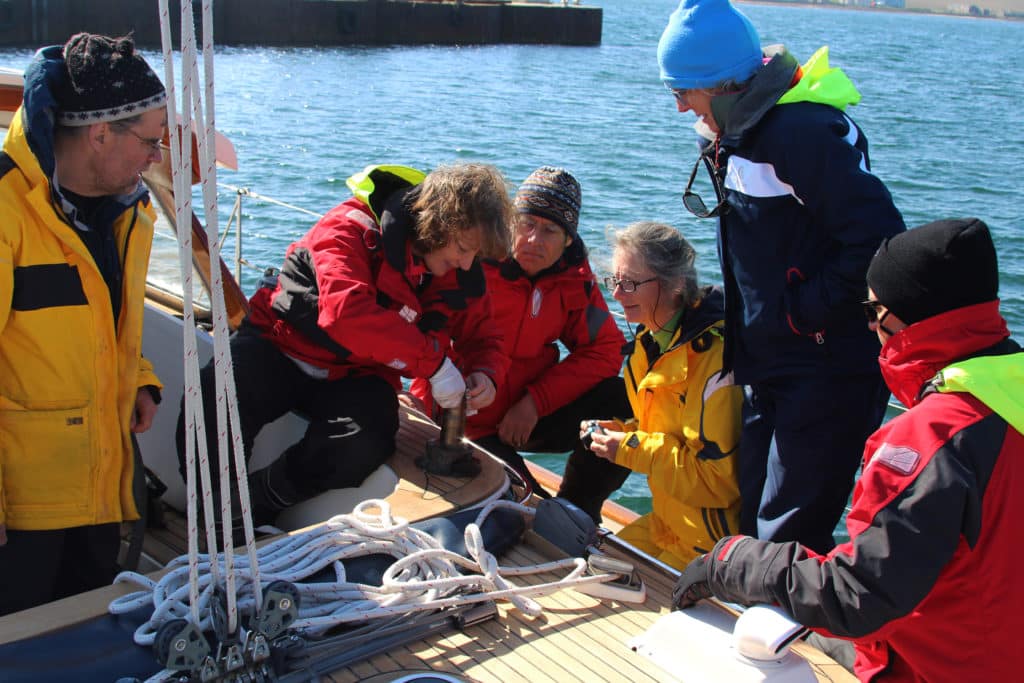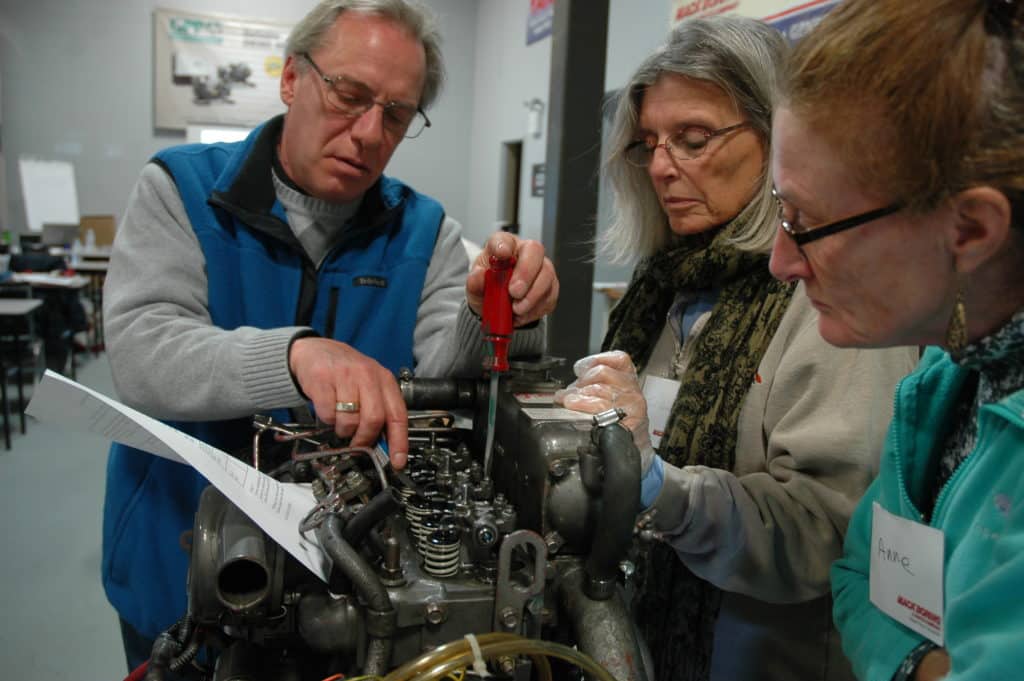
Whether you’re new to the sailing life or an old salt, the truth is that cruising boats can be complicated and a fair amount of work. Especially if you have a boat in need of some refit projects, there are an almost overwhelming number of skills to know. Even if you’re planning to have a yard do the bulk of any repairs, being able to handle small projects yourself will save money and make you a more self-sufficient cruiser. But where do you start? Fortunately, there are plenty of ways to gain the knowledge necessary to handle boat projects large and small.
Books, Videos and Webinars
Look on just about any cruiser’s bookshelf, and you will probably see a copy of Nigel Calder’s Boatowner’s Mechanical and Electrical Manual and a volume or two by maintenance guru Don Casey. Having even a small library of marine maintenance books aboard is a good idea for reference purposes, and books are a great place to start if you’re the type of learner who is comfortable reading about a project and then giving it a shot. A modern alternative to this, especially if you have a specific question, is doing a Web search and checking out forums and videos. A great place to begin is the ABYC’s website for recreational sailors and powerboaters (abycinc.org/mpage/recreationalboaters). Here you will find a video collection that covers topics such as using a multimeter and servicing a stuffing box. ABYC has also recently launched an online learning platform that offers a complete course in basic marine electrical DC and AC systems and how to prevent galvanic corrosion. The best part? You can take the course on your own schedule. Take a look on the website (abycinc.org/page/ELearning_Home) for more information.
Whether you’re installing a new through-hull or a cleat, few things are more nerve-wracking than drilling a hole in your boat. And if your boat needs fiberglass or gelcoat repairs, you want to know that you’re doing it correctly. West System has put together a library of articles and videos that cover topics ranging from repairing cracks in fiberglass to replacing balsa core and installing deck hardware. All the reference materials are available for free on the West System website (westsystem.com), and if you run into a jam, the company has technicians available by phone.
Rhode Island-based marine supplier Jamestown Distributors also has a comprehensive website (jamestowndistributors.com) that includes hundreds of videos and how-to articles and an active forum. Be sure to take a look at the company’s YouTube channel for even more videos (youtube.com/user/JamestownTV).
To learn about canvas projects and repairs, you can’t beat the resources on sewing-machine manufacturer Sailrite’s website (sailrite.com). From simple projects like how to install lifeline netting or make an interior hatch cover, to more complex cushions, sailcovers and splices, these videos will help you get on your way to adding personal touches to your boat and making it more comfortable.
Most refits involve a coat of paint somewhere, which is really just the finishing touch after lots of surface preparation. If you’re wondering where to start with your boat’s bottom, deck or topsides, check out the resources on Cruising World’s website (cruisingworld.com/1702DIY) as well as West Marine’s helpful West Advisor series (westmarine.com/westadvisor/west-advisor-articles). When the time comes to put on the first coat, all the major paint manufacturers have DIY information on their websites that can help you with preparation and paint compatibility.
There are some areas, however, where hands-on instruction from a professional is the way to go. Veteran offshore voyager and owner of Mahina Expeditions John Neal recommends that sailors who are planning to cruise long-term take courses in sail repair, diesel-engine maintenance and troubleshooting, and electrical systems. He suggests finding comprehensive one- or two-day classes, which are more feasible than longer classes if you need to travel to attend. “I also believe most people learn and retain more in an intensive learning environment, versus an hour or two once a week for several months,” Neal says.

Get Your Hands Dirty
“When it comes to mechanical skills for sailors, a good hands-on technical course certainly beats learning the hard way,” says circumnavigator and Annapolis School of Seamanship instructor Ralph Naranjo. “This is especially true when it comes to marine diesels and electrical systems.”
Options for such courses range from a free hourlong seminar at a boat show to multiday classes that can cost upward of several hundred dollars. Basic seminars will cover an intro to marine diesels — how they work and how to take care of them — while more advanced offerings dive deeper into troubleshooting and hands-on repair.
Annapolis School of Seamanship offers two levels of diesel classes: a marine-diesel basics course, which is a combination of lecture and hands-on training, and a two-day advanced course, where students are involved in the disassembly and reassembly of a sailboat-sized diesel. “The school owner, John Martino, likes to say that when your engine quits halfway to Bermuda, you’re on your own, and that’s when knowledge really counts,” says Naranjo. Classes are held throughout the year in Annapolis, Maryland. Check the website (annapolisschoolofseamanship.com) for tuition and schedule information.
When thinking about the DIY skills you need, make sure you don’t overlook your boat’s main mode of propulsion: the sails. Carol Hasse of Port Townsend Sails offers a popular sail-repair course that covers using both a palm and needle and sewing machine for such jobs as mending a seam, attaching a mainsail slide, patching holes and adding leather chafe patches. The intensive two-day schedule and small class size ensure that students have plenty of time to practice. For the schedule, check out Port Townsend Sails’ website (porttownsendsails.com/seminars.htm).
If you’re interested in diving deeper into specific topics, or if your project boat requires an extensive refit, consider a boatbuilding school. These specialized schools, such as The Landing School (landingschool.edu) and the WoodenBoat School (thewoodenboatschool.com), both in Maine, and the International Yacht Restoration School (iyrs.edu) in Newport, Rhode Island, offer full curricula covering all aspects of boat design, construction and more. There are other programs sprinkled around the country. A quick online search can put you in touch with schools in your area and their course offerings.
Putting It All Together
Martin Skelton and his partner, John Kiriluk, were starting from ground zero with nothing but a desire for the adventure of an open-ended cruise. After plenty of research and guidance, they chose their boat: a 2007 Hylas 54, which they named Genevieve. “She was probably a bit bigger than was prudent and a bit more complex than advisable,” admits Skelton. “But she was lovely and we were smitten.”
Skelton and Kiriluk tackled learning to sail by attending a weeklong course in the BVI with Offshore Sailing School, but realized that they needed much more instruction in how to maintain the boat. “The Cruisers University courses that run at the Annapolis Boat Show were a great resource for us,” says Skelton. “We signed up for a week of courses and ended up learning a great deal about everything from thunderstorms to refrigeration design, and cool boat gadgets to piloting in the Bahamas. But more important than the courses were the interactions and the people we met: other new sailors like ourselves, seasoned salts and, most important, some of the faculty, who are without exception world-class experts in their fields.”
From the foundation of knowledge that Skelton and Kiriluk acquired at Cruisers University, they realized that the next area they needed to tackle was the diesel engine. “Having never been the owner of a diesel engine before, I thought the monster under the companionway steps was mean and foreboding,” says Skelton. “So we drew the two weapons of choice to slay it: Nigel Calder’s Marine Diesel Engines book and both the basic and advanced marine-diesel courses at the Annapolis School of Seamanship. By the end of the course … the engine monster had morphed into a kitten.”
Confidence will come from using your boat and successfully completing a few projects; knowledge builds on itself. Just getting your hands dirty will teach you so much about your particular boat’s systems and quirks. “We have realized that we never will stop learning about how to keep Genevieve working, but also that it is not necessary to know everything at once,” says Skelton. “Just start with the basics, and eventually a better understanding of the systems and components will fall into place.”
Quick References
Online Learning
• ABYC (abycinc.org)
• Jamestown Distributors (jamestowndistributors.com)
• Sailrite (sailrite.com)
• Seven Seas U (ssca.org)
• West Marine (westmarine.com/WestAdvisor/West-Advisor-Articles)
• West System (westsystem.com)
Hands-On Training
• Annapolis School of Seamanship; Annapolis, Maryland (annapolisschoolofseamanship.com)
• Cruisers University; Annapolis, Maryland (annapolisboatshows.com)
• Orange Coast College School of Sailing and Seamanship; Newport Beach, California (occsailing.com)
• Port Townsend Sails; Port Townsend, Washington (porttownsendsails.com)
• The WoodenBoat School; Brooklin, Maine (thewoodenboatschool.com)
Jen Brett is CW’s senior editor.








